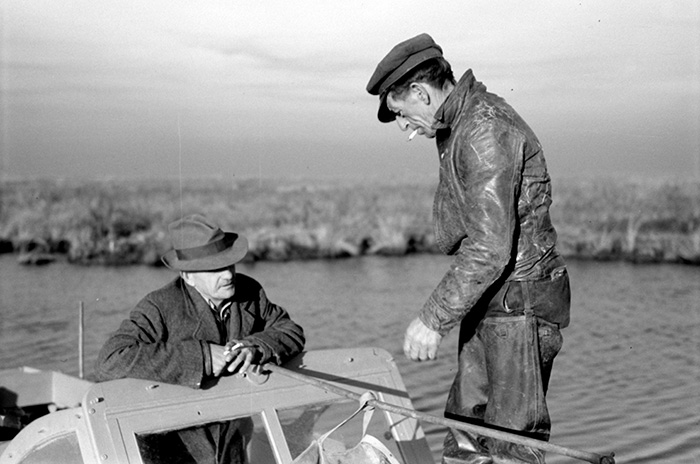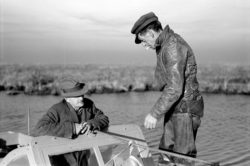Isleños
Known today as Isleños, Canary Islanders migrated to southeast Louisiana in the late eighteenth century.
This entry is 6th Grade level View Full Entry

Library of Congress Prints and Photographs Division
An Isleño trapper speaks to his helper on Delacroix Island about the scarcity of muskrats caused by flood and adverse weather conditions, 1941.
Why are Isleños significant to Louisiana’s history?
Canary Islanders immigrated to southeastern Louisiana in the late 1700s, when Spain ruled the colony. Known in Louisiana as Isleños, they settled mostly in St. Bernard and Plaquemines Parishes as well as along Bayou Lafourche in Ascension and Assumption Parishes, places with large marshland and floodplain regions that are vulnerable to flooding and hurricanes. Isleño culture has survived despite wars, natural disasters, political dissent, and the effects of Americanization, in part due to their geographical isolation and close community. They’ve played an important role in Louisiana’s history, from the 1815 Battle of New Orleans to the 2010 Deepwater Horizon oil spill.
How were Isleño communities established?
Isleños translates as “islanders” in Spanish. Louisiana’s Isleños trace their ancestry back to the Canary Islands, a group of seven islands off the coast of western Africa. In the early 1400s invaders from the Spanish peninsula colonized the Canary Islands. In the late 1770s Spanish officials hoped to increase Spanish presence in the Louisiana colony. They also sought men to help protect New Orleans from invasion. To attract settlers, Spanish officials offered Canary Islanders money, land, and support to move to the colony—an offer that appealed to many Isleños seeking to escape droughts and locust plagues. The first ship filled with immigrants, the Santissimo Sacramento, left for Louisiana in July 1778. More ships soon followed, eventually bringing around two thousand Canary Islanders to the territory.
Most Isleños arrived in Louisiana between 1778 and 1783. They were sent to four new settlements: Galveztown, Barataria, Valenzuela, and San Bernardo. Galveztown was located southeast of Baton Rouge near Bayou Manchac. Barataria was on the West Bank in present-day Jefferson Parish. Valenzuela was established on Bayou Lafourche, near the present-day town of Donaldsonville. San Bernardo, which eventually became known as St. Bernard, is located in St. Bernard Parish. The first two settlements were quickly destroyed by diseases, hurricanes, and floods because Spanish governor Bernardo de Gálvez picked them for their military usefulness, not their livability. Valenzuela and St. Bernard survived into the American period, but St. Bernard was the only settlement to keep its name and distinct Isleño identity.
Shortly after Louisiana became part of the United States, Isleños in St. Bernard participated in the Battle of New Orleans during the War of 1812. In December 1814 British forces raided villages and seized supplies and livestock as they sailed into Lake Borgne, angering local Isleños. In response, General Andrew Jackson quickly gathered a group of soldiers and civilians, including many Isleños. They helped secure victory against the British on January 8, 1815, thus confirming their new American identity.
What were the causes of the Trappers’ War?
The Isleños who came to Louisiana were mostly farmers, but they adapted over time to their new environment and started fishing and trapping mink, muskrats, and nutria. In 1926, a time when furs were popular clothing items, a violent political conflict called the Trappers’ War erupted in St. Bernard. Political leaders in St. Bernard, led by Plaquemines Parish politician Leander Perez, took advantage of the sudden fur demand by buying marshland and doubling the price for trappers to lease it. Isleños protested, but on November 16, 1926, Perez loyalists stole a gunboat called the Dolores, manned it with machine gunners, and confronted the Isleños living on Delacroix Island. There was a shootout that left one deputy dead and the boat under water. The Trappers’ War ended on November 23 when Isleño leader Manual Molero bought the marshlands from Perez and leased them back to the Isleños, just in time for trapping season.
How has Isleño culture declined and been preserved?
World War II was a turning point for the Isleños in both Valenzuela and St. Bernard. Some enlisted in the military and left their traditional cultural regions. Many on the home front took jobs in new, war-related businesses including Higgins Industries in New Orleans. After the war some Isleños moved away from the original settlement locations where their families had lived for generations. As a result, the use of Spanish and the unique Isleño dialect declined. The cohesiveness of the culture, preserved for nearly two centuries, also began to fade. Yet an effort to preserve Isleño folkways emerged in the late twentieth century. In 1975 the Los Isleños Heritage and Cultural Society was founded by historian Frank Fernandez. Fernandez worked with New Orleans’s public television station WYES to film a documentary about Isleño culture. Louisiana’s Disappearing Spanish Legacy featured aging Isleños whose oral histories inspired younger generations to preserve the past. A museum dedicated to Isleño culture was established in 1980 in St. Bernard. After relocating and restoring other historic buildings in the parish, the complex became known as the Los Isleños Heritage and Multi-Cultural Park and includes contributions from other ethnic groups.
Among Isleños’ best-preserved traditions are décimas, often-satirical folksongs with ten-line stanzas, sung a capella in Spanish. Isleño resident Irván Pérez was the most famous décima performer. Others continue to carve duck decoys, build boat models, and create intricate lace patterns from Tenerife, the largest of the Canary Islands. Caldo, a soup of beans and vegetables flavored with ham or pickled pork, originated in the Canary Islands and is still found in the Isleño culture today.
In 2005 Hurricane Katrina caused significant damage to Isleño communities. Storms and floods affected the community in the past, but Katrina weakened an already-fragile culture even more. As southeastern Louisiana gradually began to recover from the storm’s effects, thousands of people of Isleño descent moved away. Katrina destroyed Delacroix Island, the traditional center of Isleño life in St. Bernard. Cultural artifacts, photographs, and other records of Isleño history were lost. The Isleño museum and park were destroyed, but a new building opened in 2009.
In 2010 the Deepwater Horizon oil spill slowed Isleños’ recovery. A British Petroleum rig exploded in the Gulf of Mexico on April 20. In Louisiana, oil started washing up on the coast, killing wildlife and damaging the fishing industry on which many Isleños still depended. After the Gulf of Mexico cleared, the coast began to recover once again.
St. Bernard remains the most culturally intact of the four original settlements. The community continues to celebrate its Isleño roots every year with annual festivals, parades, and a museum featuring period homes, palmetto huts, maps, clothing, and other artifacts.
Baton Rouge also celebrates its Isleño heritage. A group called Canary Islanders Heritage Society of Louisiana was formed in 1996 to honor Isleños who lived in Valenzuela at one time and moved to Donaldsonville and Baton Rouge. Isleños in southeastern Louisiana continue to fight to preserve their culture, and they work with historians and anthropologists to share those traditions with the next generation.
